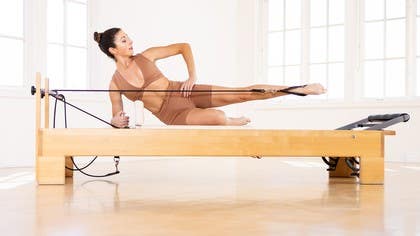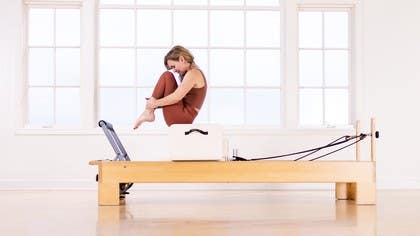
What's the Difference Between the Mat and Reformer?
If you tell an acquaintance that you practice or teach Pilates, you might be asked, “Reformer or Mat?” With the rise of group Pilates Reformer studios in the last decade, the once-mysterious apparatus (a fancy word for Pilates machine or equipment) has become more well known. Mat and Reformer are both based on the work of Joseph Pilates, who also invented the Reformer itself. For most Pilates fans, it’s not a question of choosing one or the other. Each of these apparatuses, as well as other pieces commonly found in the Pilates studio such as the Cadillac, Tower, and Wunda Chair have a special talent, much like superheroes. They also complement one another beautifully.
The Mat
The Mat work is the true foundation of Pilates. Originally consisting of 34 exercises, Pilates Mat work has spawned endless variations as the practice has grown more popular. You’ll still see the bones of the original work in most of the variations. For example, an emphasis on moving from the center, or Powerhouse, mindful breathing, and spinal mobility. Mat is not the “training wheels” version of the Reformer. It’s a challenging discipline in its own right. All of the skills that Pilates is known for developing can be acquired and refined by doing the Mat work.
Mat work is the most accessible of the Pilates repertoire. No special equipment is needed other than a soft, supportive surface, and the initial investment tends to be small. That’s why Pilates Mat classes have become a staple offering at health clubs, fitness studios, and resorts. In addition, Mat work is endlessly adaptable to all fitness levels and all life stages. It’s also familiar. Most of us have been on a Mat before, either in a yoga or fitness class or way back in a physical education class in school. As a result, with Mat work, there isn’t the intimation factor that can keep people from getting on a Reformer for the first time.
While it’s easy to get started with the Mat work, the exercises themselves are quite challenging, especially for beginners. The main difference between Mat and Reformer is that on the Mat, you use only your own body weight as resistance. There’s no footbar, springs, or straps to push or pull against. The surfaces of the Reformer also provide what Pilates instructors call “feedback,” or information that helps your brain orient your body in space. For example, while grasping the handles of the Reformer straps, you feel the play of tension between you and the pulleys that move the Reformer. With a Mat, you’re on your own. Expect a steep learning curve as you figure out how to get the most out of the exercises, rather than just making a series of shapes.
The Pilates Reformer
The Reformer consists of a flatbed, called the “Carriage,” that lies atop a metal or wood frame. When mounting the Reformer and lying down on one’s back with one’s head supported by a headrest and feet resting on a bar at the end of the frame, the first impression is “I might just settle in for a nap. How hard can this be?” That’s quickly dispelled. Underneath the carriage lies a series of springs and pulleys that control the resistance. That resistance makes the Reformer a very efficient form of exercise. While resistance training may conjure images of bicep curls or deadlifts, on the Reformer all of the muscles work against the resistance in concert. True to Joseph Pilates’ ideals, the Reformer works the muscles in a balanced way, neither under nor over-training any of them.
Unlike the Mat, Reformer Pilates is done on an elevated surface. Depending upon the exercise, you might be standing on the Reformer, several feet off the ground, balancing on one leg with your other foot perched on the footbar. At other times, you’re or lying on your back with your feet above your head, attached to leather straps. Compared to the Mat, the Reformer work is athletic, sexy, and a little dangerous.
What’s the Difference Between the Pilates Mat and Pilates Reformer?
While the Reformer and Mat are separate animals, they share a genetic DNA that is evident in the similarity of the exercises. Some exercises can be done on either piece of equipment, like the hundred or leg circles. Another similarity is that both classical Mat and Reformer work is often done in a set sequence devised by Joseph Pilates. On the Mat, classical Pilates teachers begin with the “Hundred” to warm up the body and get the breath flowing before progressing to exercises that include spinal flexion, rotation, or extension. On the Reformer, you begin with Footwork, lying on the back, and progress to more complex movements involving spinal flexion and extension. Your instructor may not adhere to the classical order of exercises, but you may spot its influence as you become more of a Pilates connoisseur.
So which kind of Pilates practitioner are you, Mat or Reformer? The good news for the Pilates fan is that you don’t have to choose. In fact, you’ll get even more out of your Reformer workouts if you combine them with Mat, and vice versa, as Joseph Pilates intended.
Comments
You need to be a subscriber to post a comment.
Please Log In or Create an Account to start your free trial.















